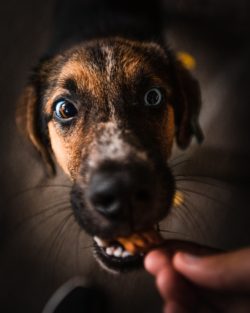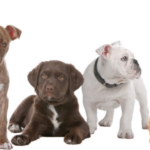Fear of storms is a common complaint amongst dog owners. Some breeds are over represented, mostly the herding breeds such as Border Collies, Australian Shepherds and their crosses. But any animal can suffer from a fear of storms.
Fears may range from fairly mild to severe panic, and you may observe signs in your pet during the mildest, most distant storms or only during closer storms. Pets will often show signs of increasing anxiety hours before the storm is even visible, or audible to us humans with our wimpy senses.
Signs you might observe in your pet include pacing, panting, shaking, dilated pupils, drooling, hiding, seeking attention or comfort through to full blown panic, frantic escape attempts and blind flight.
All animals have a set of coping skills that they use to help them remain in a more positive emotional state when they are under duress. For most pets that fear storms this will either be proximity seeking of humans, or finding a place to hide. If the coping strategies employed provide enough emotional security to balance the fear your pet is feeling, they will be able to manage through the storm. If a major coping strategy is not available (humans not home or a suitable hiding place not found for example) then pets are unable to balance their anxiety from the storm against their preferred comforting strategy. The result is increased anxiety and even panic, and this is often when we see pets seek escape in order to find a coping strategy (a human or a hide), or they have been pushed to blind panic due to the inability to reduce their anxiety. Panic can also occur if strategies your pet employs do not, under any circumstances, outweigh the fear they feel.
Other than the obvious distress pets feel during these times, escape attempts can lead to injury through accidental trauma when jumping fences, tearing at doors or jumping through glass windows. Pets running blindly around the streets are also at high risk of being hit by a car. Locking pets in rooms can induce panic, as it reduces the ability to seek out their preferred coping strategy, and may result in panic from confinement leading to household damage and injury to the pet.
How can you help your pet?
- Dampen the stimuli that upset your pet as much as you can
- Provide them with their preferred coping strategy
- Create positive associations
- Try additional strategies
- Medication
Depending on what stimulus upsets them most, you can bring them inside and draw the curtains to cut out as much of the lightning show as you can. Turn up the TV or play some music to try to drown out the thunder.
If your pet has a preferred hiding space, encourage them to use it and make it better by enclosing it with a thick blanket to dampen noise and light. If your pet seeks comfort in your presence, spend the time with them as they are using you to balance their fear. Don’t get annoyed by their ‘stickiness’ to you: they need you right now.

If they are able to, engage them in some quiet play, or simple training to provide a positive interaction against the negative emotions they are feeling. If they can’t engage you well, then that’s fine, they’re barely managing and need your support. So allow them to sit next to you, stroke them gently, massage them, and talk to them in a calm voice: you can NOT reward fear by doing this and you will not make your pet worse by comforting them. It is impossible to reward an emotion, and withdrawing comfort when your pet needs it can push their anxiety higher. You can also employ some simple counter-conditioning, if your pet is calm enough to take treat, in the form of ‘boom-cakes’. Boom-cakes are treats that are given just after every thunderclap. The premise behind this is that eventually your pet will realise that a thunderclap = incoming treat! and will feel better about the thunderclap as it heralds something tasty.

Additional strategies include Thunder Caps for those pets who find the light stimulus the most upsetting. Thundershirts can help some pets by providing full body pressure, like a hug or a weighted blanket. We have Thundershirts in clinic for trial lending if you would like to see if it benefits your pet. For those pets who find the noise stimulus most upsetting, placing cotton wool balls inside their ears for the duration of the storm (make sure they don’t eat them!) can help dull the sounds, or there are commercial earmuffs in the form of Mutt Muffs. A head and ear wrap such as the No Flap Ear Wrap could also be helpful. Conditioning a comforter such as a blanket, or teddy can also be helpful (much like children seek their comforter when upset) for some pets but takes time and training. Scents such as lavender, a smelly shirt with the owner’s scent or perfume, or pheromone therapy such as Adaptil Travel Spray can also be calming.
If no strategy can overcome your pet’s fear of storms, then we need to tilt the balance away from the negative emotions. We can do this with situational medications that reduce panic and anxiety. For extended storm seasons or people who can’t get to their pet during the day to medicate before an impending storm then blanket medication over the season can mitigate this. Come in and talk to us about options if your pet reaches panic state regularly, or has injured itself during storms before. Some medications work for some pets, some for others. Often we like to trial a dose before the event to make sure it’s effective, not sedating or exciting to them, or that your pet doesn’t have any other adverse reactions before you really need it.
What definitely won’t work for your pet?
- Abandoning them to the elements
- Not addressing the issue
- Punishing their fear
Leaving them out in the brunt of the storm to ‘get used to it’ with no coping strategies, or unable to seek their coping strategies. This technique is called flooding and rarely, if ever, results in an individual overcoming an immense fear. It can, however, lead to a syndrome called learned helplessness that looks like a calm animal, but in fact they are shut down mentally as nothing they do changes their situation so they do nothing. It’s not an ok thing to do, and it’s arguably cruel.
Waiting for them to ‘grow out of it’. True fear and phobias rarely cure themselves. People rarely grow out of being scared of snakes, or spiders, or heights. They might understand the illogical nature of their fears, but it doesn’t stop them being afraid when the stimulus is in front of them. In fact, most storm phobias get worse with time.
Punishment. Punishing them for urinating when thunder cracks right overhead, or for chewing the door frames in an attempt to get inside. Imagine being THAT scared that you actually wet yourself for real, or that you’d scrape your nails off to open a door! Besides the fact that dogs are unable to make the temporal connection between something they did hours ago and the punishment they receive now, punishing their fear response is only going to heighten it, and prove you to be a poor and unreliable source of comfort in their time of need.
Storm phobias can be difficult because storms are often unpredictable in strength, intensity and duration so it can be tough on pets who find them terrifying. Will it be a big one? What if we get a close lightning strike? What if it goes for hours? So I hope this blog has been helpful in helping you to understand why your pet does what it does during storms, and ways you can help your pet keep their emotions in a positive balance with coping strategies. As always, if you need help, please come and see us at 212 Rusden St Armidale.





